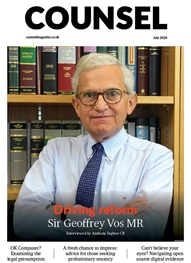*/
Professional update
The new Code of Practice for Victims of Crime has been published by the Ministry of Justice. It is divided into three main sections: enhanced entitlements for victims of the most serious crimes; persistently targeted victims and vulnerable or intimidated witnesses; entitlements for adult victims and corresponding duties on service providers; and entitlements for children and young people and corresponding duties on service providers.
Amongst the key entitlements are being kept informed, including being kept informed about the stages of the process from the arrest of the suspect, to have special measures explained to them and where circumstances permit to meet the prosecutor and to ask him or her questions about the court process. There are further sections about victim personal statements, restorative justice and applying for compensation. In terms of investigation, paragraphs 1.5 and 1.6 set out in detail what the police must do when interviewing a victim and which in turn should be preceded by a “needs assessment” of what support the witness needs. All this now has the same status as the PACE codes and a court can take them into account if they are breached.
In addition, paragraph 3.3 obliges the prosecutor to seek the court’s intervention when cross-examination is considered by the prosecutor to be inappropriate or too aggressive.
The new Victims’ Code should be read in conjunction with the Criminal Practice Directions issued by the Lord Chief Justice in October (which makes even more specific rules about the allowable means of cross-examining a vulnerable witness and the need to follow the Advocate’s Gateway Toolkits), and the newly issued Equal Treatment Bench Book from the Judicial College, which goes further in recommending flexibility in the court’s approach in adapting the process in order to allow vulnerable witnesses to give their best evidence. All this dispels the misconception that arose following the Brewer trial earlier this year: it is in fact good practice that a vulnerable witness who has refused special measures is still to be treated as a vulnerable witness.
Amongst the key entitlements are being kept informed, including being kept informed about the stages of the process from the arrest of the suspect, to have special measures explained to them and where circumstances permit to meet the prosecutor and to ask him or her questions about the court process. There are further sections about victim personal statements, restorative justice and applying for compensation. In terms of investigation, paragraphs 1.5 and 1.6 set out in detail what the police must do when interviewing a victim and which in turn should be preceded by a “needs assessment” of what support the witness needs. All this now has the same status as the PACE codes and a court can take them into account if they are breached.
In addition, paragraph 3.3 obliges the prosecutor to seek the court’s intervention when cross-examination is considered by the prosecutor to be inappropriate or too aggressive.
The new Victims’ Code should be read in conjunction with the Criminal Practice Directions issued by the Lord Chief Justice in October (which makes even more specific rules about the allowable means of cross-examining a vulnerable witness and the need to follow the Advocate’s Gateway Toolkits), and the newly issued Equal Treatment Bench Book from the Judicial College, which goes further in recommending flexibility in the court’s approach in adapting the process in order to allow vulnerable witnesses to give their best evidence. All this dispels the misconception that arose following the Brewer trial earlier this year: it is in fact good practice that a vulnerable witness who has refused special measures is still to be treated as a vulnerable witness.
Professional update
The new Code of Practice for Victims of Crime has been published by the Ministry of Justice. It is divided into three main sections: enhanced entitlements for victims of the most serious crimes; persistently targeted victims and vulnerable or intimidated witnesses; entitlements for adult victims and corresponding duties on service providers; and entitlements for children and young people and corresponding duties on service providers.


The Chair of the Bar sets out how the new government can restore the justice system
In the first of a new series, Louise Crush of Westgate Wealth considers the fundamental need for financial protection
Unlocking your aged debt to fund your tax in one easy step. By Philip N Bristow
Possibly, but many barristers are glad he did…
Mental health charity Mind BWW has received a £500 donation from drug, alcohol and DNA testing laboratory, AlphaBiolabs as part of its Giving Back campaign
The Institute of Neurotechnology & Law is thrilled to announce its inaugural essay competition
How to navigate open source evidence in an era of deepfakes. By Professor Yvonne McDermott Rees and Professor Alexa Koenig
Brie Stevens-Hoare KC and Lyndsey de Mestre KC take a look at the difficulties women encounter during the menopause, and offer some practical tips for individuals and chambers to make things easier
Sir Geoffrey Vos, Master of the Rolls and Head of Civil Justice since January 2021, is well known for his passion for access to justice and all things digital. Perhaps less widely known is the driven personality and wanderlust that lies behind this, as Anthony Inglese CB discovers
The Chair of the Bar sets out how the new government can restore the justice system
No-one should have to live in sub-standard accommodation, says Antony Hodari Solicitors. We are tackling the problem of bad housing with a two-pronged approach and act on behalf of tenants in both the civil and criminal courts